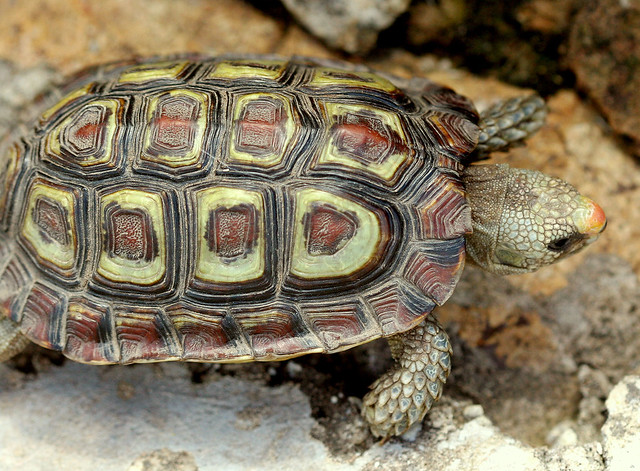Cladus: Eukaryota
Supergroup: Opisthokonta
Regnum: Animalia
Subregnum: Eumetazoa
Cladus: Bilateria
Cladus: Nephrozoa
Cladus: Deuterostomia
Phylum: Chordata
Subphylum: Vertebrata
Infraphylum: Gnathostomata
Superclassis: Tetrapoda
Classis: Reptilia
Subclassis: Anapsida
Ordo: Testudines
Subordo: Cryptodira
Superfamilia: Testudinoidea
Familia: Testudinidae
Genus: Homopus
Species: Homopus areolatus
Name
Homopus areolatus (Thunberg, 1787)
Synonyms
* Testudo areolata
* Testudo miniata
* Chersine tetradactyla
The beaked cape tortoise or parrot-beaked padloper (Homopus areolatus) is a tiny species of tortoise of the Homopus genus.
It is endemic to the Republic of South Africa and is found specifically in the Western Cape Province. Like its larger relative, the Karoo cape tortoise, it has only four toes on its front feet. It has a sharp, distinctly hooked beak and the noses of the males become bright orange or red in the breeding season.
Due to its tiny size, this tortoise is heavily preyed on by crows, jackals, dogs and a wide range of other predators. Consequently, it spends most of its time hiding under rocks, foliage and other cover. It is threatened by traffic on roads, overgrazing, introduced species and poaching for the pet trade (Homopus species do not generally survive well in captivity). [2]
References
^ JCVI.org (Retrieved March 17, 2010).
^ Membres.multimania.fr (Retrieved March 17, 2010).
Photo Links
http://sites.google.com/site/jackdt/2006-09-02homopus-areolatus2-perdekop-thea.jpg
Additional reading
Chelonia.org
Baard, E.H.W. 1996. Inter- and Intra-Individual Variation in the measurement of southern Padloper Homopus areolatus Afr. Herp News (25): 22-25
Bour,R. 1980. Essai sur la taxinomie des Testudinidae actuels (Reptilia, Chelonii). Bull. Mus. natl. Hist. nat. Paris (4) 2 (2): 541-546
Duméril, A. M.C., G. BIBRON & A. DUMÉRIL 1854. Erpétologie générale ou Histoire Naturelle complète des Reptiles. Vol. 9. Paris, XX + 440 S.
Ernst, C.H. and Barbour,R.W. 1989. Turtles of the World. Smithsonian Institution Press, Washington D.C. - London
Fleck, J. & Fleck, S. 2001. Erfolgreiche Nachzucht von Chersina angulata und Homopus areolatus über mehrere Jahre. Elaphe 9 (3): 5-14
Fritz, Uwe and Olaf R.P. Bininda-Emonds 2007. When genes meet nomenclature: Tortoise phylogeny and the shifting generic concepts of Testudo and Geochelone. Zoology 110 (4): 298-307 [erratum in vol. 111 (1): 84]
Gorseman, P. 1980. Opmerkingen over biotoop en voortplanting van Homopus areolatus. Lacerta 38 (10-11): 107-111
Greig, J.C., and P.D. Burdett. 1976. Patterns in the distributions of Southern African terrestrial tortoises (Cryptodira: Testudinidae). Zool. Africana 11(2): 250-267.
Hoogmoed, M.S. 1980. Herpetologische waarnemingen in Ghana [part 8]. Lacerta 38 (10-11): 112-116
Lacepède, B. G. E. 1788. Histoire Naturelle des Quadrupe des Ovipares et des Serpens. Vol.1. Imprimerie du Roi, Hôtel de Thou, Paris, xvii + 651 pp.
Loveridge, Arthur & Williams, Ernest E. 1957. Revision of the African Tortoises and Turtles of the Suborder Cryptodira. Bulletin of the Museum of Comparative Zoology 115 (6): 163-557
Schleicher, A. 2005. Die Areolen-Flachschildkröte, Homopus areolatus (THUNBERG 1787). Beobachtungen und Erfahrungen: Lebensweise, Haltung, Nach- und Aufzucht. Reptilia (Münster) 10 (6): 36-40
Schleicher, A. 2005. Homopus areolatus - The Parrot-Beaked Tortoise. Reptilia (GB) (43): 26-30
Thunberg, C. P. 1787. Beskrifning pé Trenne Skölpaddor [Description of two new turtles] Kongl. Vetenskaps Academiens Nya Handlingar, För M_naderne 1787 (Julius, Augustus, September): 178-180
Hughes, B. 1986. Longevity Records of African Captive Amphibians and Reptiles: Part 1: Introduction and Species List 1 - Amphibians and Chelonians Jour. Herp. Ass. Afr. (32): 1-5

